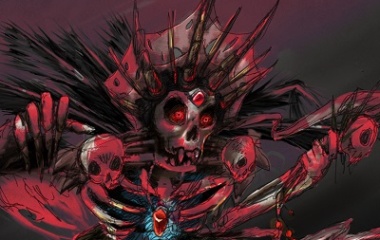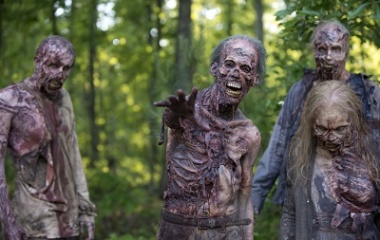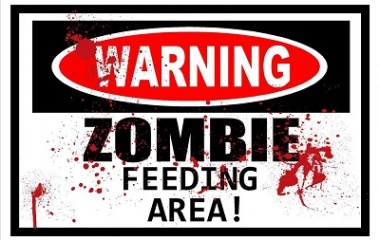What Are the Undead?
The Undead are mythological creatures, usually monstrous, who exhibit characteristics of living beings after they are deceased. Their level of sophistication varies from creature to creature and story to story. For example, Bram Stoker’s Dracula, a classic Undead character, is well dressed, smooth spoken, and at times indistinguishable from a living person. On the other hand, the Undead zombies who ravage today’s horror and sci-fi novels are grotesque, unintelligent, and uncoordinated.
The Undead are, without doubt, a motley and diverse crew, but some of their characteristics are universal. The Undead are able, at the very least, to move around and manipulate their environments. They are usually interested in the living and attempt to either communicate with them or prey on them, and they are not vulnerable to death by natural causes.
History and Evolution
Legends about the afterlife are as ancient as human culture itself, and for almost as long as the afterlife has gripped our imaginations, Undead creatures have been crawling out of it.
“Vampire graves” uncovered in the ruins of ancient Greek-Bulgarian cities show that people were taking precautions against the rise of the Undead as early as 800 years ago. Corpses suspected of getting itchy feet were buried upside down or with stakes driven through their hearts.
During China’s Qing Dynasty, which reached its golden peak over 400 years ago, scholars discussed a popular Undead creature belonging to Chinese folklore. This creature was said to sleep during the day, hunt at night, and suck the life force out of living victims. At the same time, Undead creatures appeared in the epic poems of Norse mythology, ready and capable of killing if their graves were disturbed.
In the past 200 years, the Undead have undergone considerable changes. While they are still the stuff of horror films, they are undoubtedly more glamorous, even more human, than they used to be.
Mary Shelly’s Frankenstein and Bram Stoker’s Dracula were both pivotal to the rebirth of the Undead. These novels, published during the heyday of the Gothic romance period, made the first shuffling steps towards an Undead monster that readers could relate to. They would be followed, years later, by the Twilight series and its endless spin offs, which ushered Undead creatures into the spotlight as beautiful, romantic, and misunderstood heroes.
Finally, as dystopian and apocalyptic literature rose in popularity, TV shows like The Walking Dead and movies like Night of the Living Dead and World War Z have returned the Undead to mindless, bloodhungry monsters. Tellingly, however, the ferocious appetite and violent strength of the Undead is not the true horror of these films. The true horror is psychological; it’s the knowledge that the living are just one bite away from joining the ranks of the Undead.
Over time, the Undead have evolved from terrifying monsters, who inspired common folk to hang garlic in their windows and keep vials of holy water in their pockets, to cautionary symbols, who we can identify with and learn from.
Types of Undead
Vampires
Of all the Undead creatures, vampires bear the strongest resemblance to the living. They are usually physically attractive, but if you look closely, you might be unsettled by their pale skin, sharp teeth, and shadowy, color-changing eyes. Vampires can keep up in a conversation. In fact, they often have an air of wisdom and sophistication; they might be hundreds of years old and have amassed great wealth and knowledge over the years. They have complex emotions and plans, and they can often blend into a population of living people without detection.
A living person becomes Undead when they are bitten by a vampire. Once bitten, you might transform immediately into a vampire, or might transform only when you die. Often, a vampire bite leads to a quick death, as the vampire continues to drain the blood from his victim’s body.
Like most other Undead creatures, vampires are immortal beings. They can’t die of natural causes. However, they can be destroyed if they are exposed to sunlight, if their heads are cut off, or if a wooden stake is driven into their hearts.
In Chinese folklore, the jiangshi is similar to a vampire. These are nocturnal hunters risen from the dead, but instead of sucking blood, they suck qi (or life force) from their victims.
Liches
Although liches could never stand up to vampires in a beauty contest, they are among the most advanced of the Undead creatures. They have all the cunning and complex desires of a living creature, and many of them are even in possession of their souls.
Powerful magicians who desire immortality may enter an Undead state by transforming themselves into liches. The transformation is complicated and usually involves transferring their soul into a phylactery, a magical object which traps and protects the soul. The new lich’s body will gradually shrivel into a skeletal condition, but it will remain limber and will be directed by the soul.
Liches are dangerous enemies, but their Undead state can only last as long as the phylactery is intact. If the phylactery is destroyed, the lich’s soul will lose its grip on the earth, and the body will collapse into an inanimate form.
Zombies
Zombies are perhaps the crudest form of the Undead. Although they are animate, their bodies are not well preserved. They are actively decomposing and, not surprisingly, their movement and thought process is clumsy. They have retained only the most primitive survival instincts from the days when they were alive. They eat, and they defend themselves if attacked.
There are lots of ways for a living person to be converted into one of the Undead zombies. His corpse might be magically or scientifically re-animated, he might be exposed to a zombie pathogen while he is living, or he might be bitten by a zombie.
Zombies don’t die of natural causes, and destroying them is no easy task. They are un-phased by most injuries; rip a zombie’s arm off or shoot a hole in his stomach, and he’ll just keep coming at you. The only surefire way to stop a zombie is to destroy his brain—or break his body into such small pieces that none of them pose a threat.
Mummies
Mummies rival zombies for the position as the most primitive Undead creature. Petrified and bound in cloth, mummies are poorly coordinated and have no social skills, just like zombies. Perhaps the biggest difference between mummies and zombies are the impulses that drive them. While zombies are driven only by survival instincts, mummies are a little more complex. They usually exist to guard the body of a deceased ruler or a treasure, and they will hunt down anyone who disturbs the tombs they guard.
The mummy’s path into the realm of the Undead is by far the most complicated. After a person is deceased, their corpse must be prepared through an elaborate ritual, which involves both embalming techniques, to preserve the body, and magical incantations, to instruct the spirit about its Undead responsibilities.
Once a mummy has been roused and become an active Undead creature, getting rid of it is difficult. Like zombies, mummies aren’t slowed down by physical injury. Fire or a magical incantation are the most common weapons used against mummies.
In Norse mythology, draugrs are very similar to mummies. They guard the tombs and treasures of deceased Normans.
Ghosts
Ghosts are unusual among the Undead in that their bodies are not animate. Only their spirits persist in an Undead form. Still, ghosts aren’t powerless in the physical world. They can appear in shadowy or translucent shapes, and they can use the energy of their restless spirits to cause temperature changes or flickering lights. They can also slam doors, send objects flying across the room, and make spooky noises.
Unlike the other Undead creatures, ghosts usually choose to enter the realm of the Undead. They often have some unfinished business with the realm of the living, and they aren’t ready to retire into death. Often, ghosts choose an Undead existence because their lives came to a traumatic end. They might want to pass along a message to the living, so that their deaths can be avenged, or they might be so shocked by their own grisly end that they are unprepared to accept death. Occasionally, a ghost might hang around for a more peaceful reason. Perhaps, the ghost is unwilling to leave behind a loved one or a cherished place.
Because ghosts choose their Undead existence, the best way to get rid of them is to convince them to relinquish the last shreds of their existence on earth. Settling a vendetta for a ghost or simply empathizing with them and counselling them through the trauma of their death can help them decide to move on to the realm of death.
Banshees
Like ghosts, banshees do not have a concrete Undead form. They might appear as beautiful pale women, hags, or washing women, but they aren’t bound to these bodies. If approached, a banshee can turn into a small animal or vanish into curls of mist.
How exactly a banshee enters the realm of the Undead is uncertain. They are said to be the spirits of murdered women or women who died in childbirth, and they are bound to the earth by servitude to a specific family. The banshee warns the family, with her piercing, mournful cry, when one of its members is going to die.
Although their cries may be eerie, Banshees are benevolent creatures. They are not easily shaken from the families they serve, nor do the families try to drive banshees away.










